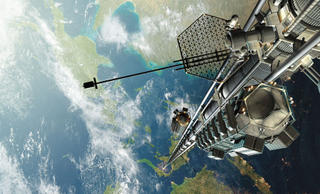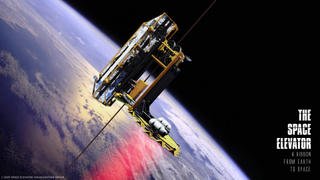
Update
Here's the latest on the Space Elevator concept.
I've linked it, but here's the text in its entirety.
One day in the future, not too far from today, a hazy weekend in Mountain View could be written into the history of space exploration.
A three-day competition at the NASA Ames Research Center, which wrapped up Sunday, brought together callow college students and grizzled engineering hobbyists to design a ``space elevator'' -- a platform rising beyond the Earth's atmosphere along a super-strong ribbon of carbon ``nanotubes'' that could, one day, carry cargo into space much more cheaply than rockets.
Just as the first airplane flight at Kitty Hawk lasted only 12 seconds, the seven ``robot climbers'' entered in the competition didn't ascend more than a few dozen feet up a tether attached to a giant crane. And none performed well enough to win the $50,000 grand prize.
But they broke a barrier on Sunday nonetheless -- proving that the idea is not some science-fiction fantasy.
``If we get financing, it'll be one or two years'' before a space elevator becomes a reality, said Brad Edwards, a former staff scientist at Los Alamos National Laboratory who has written a book on the subject.
Edwards was a judge at the competition, sponsored by the Spaceward Foundation of Mountain View. Just as railroads opened up the western United States and the Internet opened up cyberspace, Edwards believes that a space elevator will lead humanity across yet another frontier.
While rockets are prohibitively expensive because of their fuel, a space elevator could cover the same distance for a tiny fraction of the cost, Edwards said. It could be used to cheaply launch satellites or missions to Mars.
It could even solve the energy crisis by lifting massive banks of solar cells into orbit around Earth, proving unlimited clean, efficient and safe power. ``You can't do that with rockets,'' Edwards said.
Contestants were asked to develop either a super-strong elevator tether or a robotic platform that would climb up the tether into space.
Four teams entered the tether contest, according to Marc Schwager of the Spaceward Foundation. That contest also had a $50,000 prize, offered by the NASA Centennial Challenges Program -- but to win it, a team had to demonstrate that their tether was not only stronger than others entered in the competition, but also 50 percent stronger than NASA's ``house tether.''
Schwager said a tether developed by a three-man team from Logan, Utah, beat the other teams but broke just before reaching the 50-percent prize threshold. Since nobody won either prize this year, Schwager said the money for both the climber and the tether will be rolled into next year's pot.
The idea of offering prizes to spur scientific breakthroughs dates back to at least 1714, when the British government offered the ``Longitude Prize'' for the first method to precisely determine a ship's longitude.
But contestants in the Spaceward Foundation challenge said they weren't motivated by money as much as by the idea of creating something that crossed a scientific frontier.
Michael Fischer, a 50-year-old software engineer from Auburn, put about $5,000 into a climber powered by a Stirling engine using external combustion and helium.
At the last minute, Fischer's climber developed a leak, so he ended up cannibalizing it for parts to help other teams, including one from the University of British Columbia.
That team of students, led by Steve Jones, came in second, with a climber that converted the light from powerful spotlights into energy. It rose about 30 feet, while the winning team, from the University of Saskatchewan, used light to climb 60 feet.
``It was amazing to watch these silent machines gliding on light,'' Schwager said. ``Two college teams came in and showed industry how to build a space elevator.''

It has to be said, it's hard to visualise whhat exactly the elevator shaft/stem is going to look like, but there you go.
I actually think there's an idea for a start up company in it right now.

2 comments:
There is indeed Art. Check out "The Space Elevator" by B.C.Edwards & E.A.Westling. All the engineering is done but for nanotubes of decent lengths (>about .5-1m). We are making industrial quantities of milimeter lengths but when the lengths get up we can do the composites and the rest - as they say - is (will be) history.
This idea has gone beyond fiction now. I only wish I knew where to invest once the long tubes are made!
db
I want in on that company NOW. :)
Post a Comment